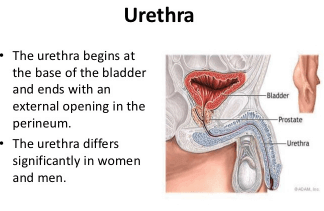Urethra
What is Urethra?
The urethra is a tube like structure, which serves as the passageway for urine excretion in the body. It connects the bladder to the external part of the body. The tube is made of fibro-muscular tube that opens at the lower opening of the bladder through the pelvic and extending to the outside.

Female and Male Anatomy
The urethra exists in both males and females. In males, it is made up of three sections, which include; prostatic, spongy and membranous part. The tube traverses the whole length of the penis thus it is quite long with a length of about 20 cm. It is dual purposed meaning it is the passage of urine and also serves as the passage for semen during ejaculation.
For females, the urethra is quite short having a length of about 4 cm. It is found between the clitoris and vagina. Unlike in males, the urethra in females is solely for urine excretion.
How Does the Urethra Work?
The working of the urethra is determined by the action of the receptor cells present in the bladder. Once these cells detect that the bladder is full, the sphincter- which controls the passage of urine is stimulated to open. The process can occur both voluntarily or involuntarily.
For voluntary, an individual is able to control passing urine until when he or she reaches the bathroom, but for involuntary case the control is exceeded. This (involuntary situation) occurs when the bladder is too full to hold the urine. 4
Complications
The urethra, in some cases, may get complications, which may require medical attention. Three main complications include:
- Urethral strictures
- Urinary tract infection
- Urethral cancer
Urethral Strictures
The width of the urethra usually enables free flow of urine without any restrictions, but owing to some conditions, it may narrow. This results to the condition known as the urethral stricture, which limits urinary flow. It mainly occurs in men.
Symptoms
The symptoms likely to manifest in urethral strictures are:
- Pain or burning sensation when passing urine
- Having regular urges to urinate
- Reduced urine
- Incapability of passing urine
- Frequent pain around the abdominal area
- Lack of urine control
- Swelling and pain around the penile region
- Presence of urethral discharge
- Production of dark colored urine
- Production of semen with blood

Causes
There are many causes of urethral strictures, some include:
- Inflammation of urethral tissues
- Penile implants increases the chances of urethral stricture development
- Occurrence of scar tissues in the urethra
- Straddle injuries like being hit in the areas near the scrotum
- Hypospadias surgery- corrective surgery for underdeveloped urethra
- Prostate surgery
- Pelvic fractures
- Radiation
- Prostatic hyperplasia
- Could also be caused rare cases such as:
- Tumor developed near the urethra
- Sexually transmitted infections such as Chlamydia and gonorrhea
- Urinary tract infections
Diagnosis
There are a number of tests that doctors may use to rule out the presence of a stricture. They comprise:
- Tests on the physical properties of urine. In this case, blood and bacteria are the key properties sought
- Rate of urine flow can be measured
- STIs test can be conducted
- Cystoscopy may be conducted. This involves the insertion of a small tube that holds a camera into the body to bring the stricture to view.
Treatment
Urethral stricture treatment is widely divided into surgical and non-surgical kind of treatments.
Non-surgical
This involves the use of an instrument known as a dilator to widen the urethra. Urinary catheter placement could be considered for severe retention cases.
Surgical
Depending on the severity of the case, a doctor may suggest the surgery that best suits you.
- Urethroplasty- this involves urethral tissue removal and reconstruction
- Urine flow diversion- this is done when the bladder is damaged or needs removal. It involves directing urinary flow through the abdomen.
Prevention
Individuals can prevent having urethral strictures by:
- Using protection to prevent contracting STIs
- Seeking medical assistance immediately you notice any of the symptoms.
Urinary Tract Infections
UTIs are commonly caused by bacteria, which move up the urethra finding their way into the bladder. In the bladder, the infection spreads and is more prevalent in females than males due to their shorter urethra. Urethritis is the most common type of infection that affects both men and women.
Symptoms
The symptoms for urethritis are such as:
- Burning sensation during urination
- Oral or anal infections
- Regular urination
- Less volume of urine produced
- Blood in urine
- Pain and irritation around the penile region
- Urethral discharge (yellowish in color)
- Abdominal pain (lower regions)
- Pain during sex for women
Causes
Urethritis may be caused by different things including:
- STIs like herpes, Chlamydia and gonorrhea
- Anal bacteria finding their way into the urinary tract (in women)
- Sexual bruising in women
- Extended use of the urinary catheter
- Some soaps, vaginal douches, or bath oil products used by women.
Diagnosis
A doctor may use different methods to diagnose a case of urethritis.
- The doctor will use the patient history as a base and conduct further physical examinations
- Microscopic examination of urine and urethral discharges
- Culture for Chlamydia and gonorrhea.
Treatment
Urethritis may be treated in the following ways:
- Antibiotics for bacterial infections
- Cranberry juice is known to increase the acidity of urine, which is effective in the uptake of UTI medication
- For relieving pain, analgesics are prescribed.
Prevention
You can prevent urethritis by ensuring the following:
- Abstaining is the surest prevention measure
- Always use protection
- Good hygiene practices
- Drink more liquids and avoid caffeine to prevent recurrence
- Women should wipe from front to back after using the bathroom to avoid spread of fecal bacteria
- Frequent visits to the doctor
Urethral Cancer
The cells in the urethra, due to some risk factors may become malignant thus affecting replication causing cancerous growth. Squamous cells carcinoma is the most common type of urethral cancer. Risk factors include:
- STDs
- UTIs
- Bladder cancer
- Individuals with 60 years of age or more
- Being a white female also increases your chances of getting cancer as per research.
Symptoms
The following symptoms could indicate that you may be having urethral cancer. You need to visit a doctor for screening of you notice these symptoms and signs.
- Discharge of blood from the urethra
- Presence of blood in the urine
- Frequent and urgent urination
- Swelling around the perineum
- Swelling of lymph nodes around the groin area
- Urethral discharges
- Slow or weak urinary flow.
Diagnosis
Diagnosing urethral cancer involves one or more of the following techniques:
- Urine or blood tests
- Sample biopsies may be conducted
- Cytoscopy (insertion of a tube with camera to bring the affected area in view)
- Rectal and pelvic examinations
Treatment
Treatment of cancer is much effective and successful if the disease is diagnosed before it has shown symptoms or advanced to serious stages. If you are at risk of having urethral cancer or any other form of cancer, you would better ensure you get regular checkups and screening. Treatment for urethral cancer may include:
- Surgery
- Chemotherapy
- Radiation therapy
Reference List
- Female Urethra Pictures, Anatomy and Diagram. Available at http://www.healthline.com/human-body-maps/female-urethra
- Urethral Cancer: Learning About Staging and Treatment. Available at http://www.medicinenet.com/urethral_cancer/article.htm
- Urethral stricture: Causes, Symptoms and Prevention. Available at http://www.healthline.com/health/urethral-stricture#treatment6
- What is the urethra? Available at http://www.news-medical.net/health/What-is-the-Urethra.aspx
- What is Urethritis? – Urinary Tract Infection. Available at http://www.healthcommunities.com/urinary-tract-infection/urethritis.shtml
